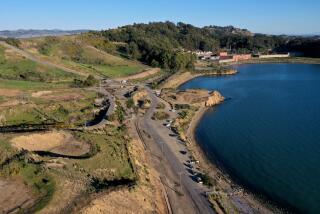Back Bay Makes Up Oasis of Wild Things
- Share via
It can be an almost shocking sight, especially late on a summer day when the sun flares off the surface of the water like hammered gold, and it can sneak up on you. You may have just driven off the freeway at Jamboree Road, maybe after winding your way past the tightly packed commercial towers of the airport district or skirting the nearby concentrated residential districts on the Costa Mesa-Newport Beach boundary.
And then, suddenly, appear 752 acres of . . . open space. Marshes and mud flats and small islands, willows and channels of water stretching down to the harbor, a great slash of undeveloped land in the middle of one of the most relentlessly developed sections in California.
But the Newport back bay may be more populous than even the most dense of condominium projects. Since 1975, the area has officially been home to 165 species of birds, 78 types of fish, 20 species of mammals and a botanist’s smorgasbord of plant life. It was in that year that the back bay was designated the Upper Newport Bay Ecological Reserve by the California Fish and Game Commission.
And, as a kind of wide-open park with easy access and often-spectacular views, it has become one of the most popular places in the county for naturalists, fishermen, joggers, cyclists, bird watchers and anyone else who craves a little time away from traffic and noise.
“We get everyone out there,” said Ron Hein, an associate wildlife biologist with the state Department of Fish and Game. “I’ve met people there from Ireland, from England. They’re basically the naturalist, birder types. And then there are the people who are just looking for some kind of natural environment to have lunch, spend a few minutes.
“The general impression is that they’re most amazed that we have a little niche in the urban, industrial, commercial environment that they can enjoy.”
The back bay was inhabited at one time by a group of Indians known to historians as the Gabrielinos, who came to the area 2,000 years ago and disappeared with the coming of the California missions. Pirates, probably among the first Europeans to come to the coast, also hid in the bay, and in the 1790s a group of French colonists made a stop there.
In the 1830s, one of the county’s most famous residents, Don Jose Andres Sepulveda, established Rancho San Joaquin and built his hacienda at the head of the bay at what is now the San Joaquin Golf Course.
Today, the most visible residents of the bay are the birds. Several types of ducks, coots, grebes, curlews, sandpipers, avocets and other marine and shore birds make their temporary homes there, mostly during the fall-winter migratory period, August to April (another smaller migration occurs in summer). Other birds found in the bay’s fresh-water marshes are song sparrows, marsh wrens, yellowthroats and red-winged blackbirds. In the uplands are mockingbirds, road runners and hummingbirds.
Another small bird, Belding’s savannah sparrow, is found only in the salt marshes of the bay. This subspecies is on the endangered list because its habitat is fast disappearing in Southern California, which is the only place the bird is found.
Among the mammals found mostly in the upland areas are ground squirrels, cottontail rabbits, raccoons, long-tailed weasels, skunks and gray foxes.
Halibut, croaker, white sea bass and barred sand bass spawn in the bay. The best fishing spots, according to state Fish and Game officials, are directly off Big Canyon and off North Star Beach. Small boats may be launched free at Big Canyon.
Tours are conducted by the Friends of the Newport Bay once a month, October to March, during the height of the fall-winter bird migration. Fullerton College also conducts special tours by appointment for school classes and similar groups.
The Natural History Foundation of Orange County also maintains a collection of artifacts and provides lectures, field trips and displays relating to the bay.
UPPER NEWPORT BAY ECOLOGICAL RESERVE
What: A total of 752 acres of coastal wetlands preserved as a sanctuary for wildlife.
Where: North of Coast Highway, between Big Canyon and Dover Shores in Newport Beach.
Wildlife: 165 species of birds, 78 species of fish and 20 species of mammals.
Recreation: Walking, jogging and cycling around Back Bay Drive. Swimming permitted in designated areas. Boating (launching at Big Canyon is free; a fee is charged for launching at Newport Dunes). A foot and horse trail winds around the north end of the bay.
Tours: Offered monthly from October through March by the Friends of Newport Bay (646-8009). Tours for school groups and others by appointment through Fullerton College (871-8000, Ext. 269). The Natural History Foundation of Orange County provides lectures, displays and field trips (545-8967).
More to Read
Sign up for Essential California
The most important California stories and recommendations in your inbox every morning.
You may occasionally receive promotional content from the Los Angeles Times.













